
Right-Sizing ESSA Accountability
Five Approaches to Balance State and Local Priorities with Federal Requirements
A common critique of the school accountability requirements in the Every Student Succeeds Act (ESSA) is that federal requirements stifle innovation. I agree that ESSA can be improved; my colleagues and I have outlined some recommendations for its next reauthorization. Even so, I contend that states can pursue accountability improvements now, without waiting for reauthorization.
This isn’t a new idea. We describe some approaches in a recent paper. Brian Gong describes others in a blog series explaining that states have flexibility under ESSA and sharing some examples for states and districts.
Building on these publications, I’ll focus now on how state education agencies can create an accountability mix that right-sizes federal requirements and their own priorities, by blending or separating those two elements in various ways.
Five Models
I believe there are at least five models for addressing federal requirements and state priorities in accountability. I’ll use a series of illustrations to describe these models.
Here’s a quick key that explains the illustrations:
- Circles: potential accountability components. Their size conveys their proportional influence.
- Shaded circles: state actions
- Unshaded circles: areas not directed by the state
The positioning of the circles can be read like a Venn diagram to indicate if elements overlap.
Now, let’s get to the models.
1. Single Streamlined System
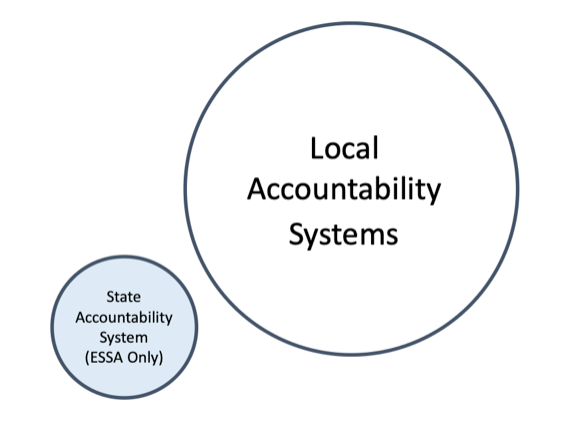
The first model represents an approach in which the state intentionally downsizes the influence of ESSA in order to increase the role of local accountability. In this approach, the state may do the bare minimum to comply with ESSA, such as incorporating only its required indicators and producing only the school designations. The rest is left up to Local Education Agencies (LEAs).
The idea is to shift the emphasis for accountability primarily to LEAs with minimal constraints from federal requirements. This may be an attractive option for those who feel LEAs are best positioned to drive the kinds of accountability innovations that will improve schools.
2. Single Streamlined System Plus Supplemental Supports
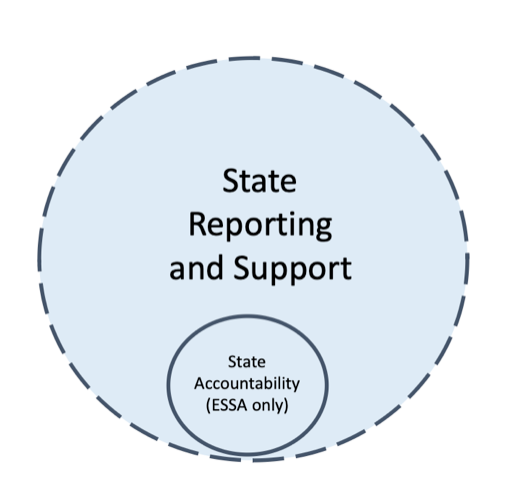
Like model one, the second model features a very “light footprint” ESSA system. However, in this approach the state doesn’t relinquish everything else to the LEAs; instead, it shifts the emphasis to providing more in-depth information and resources outside of formal accountability.
The dashed lines are meant to show that the state’s role outside of ESSA is distinct from the way most think about the state’s role in accountability systems. For example, the state could provide a reporting “dashboard” or focus on providing research, model resources, or other support to LEAs. None of these elements influence school scores or labels.
Model two may be appealing to those who see the state as having an important role in reporting and support, but want to minimize the influence of ESSA.
3. Single Broad System
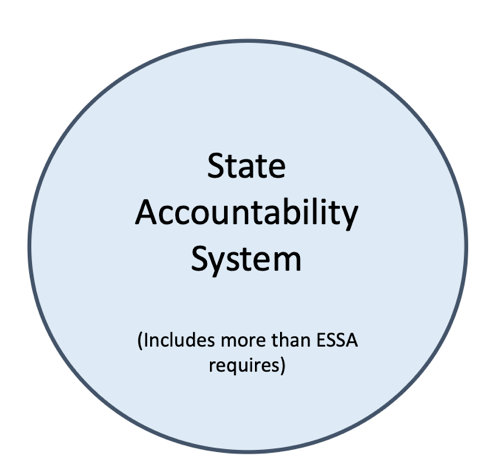
The third model represents an attempt to integrate the requirements of ESSA into a broader system that reflects a fuller range of state’s priorities. This approach may appeal to those who feel the ESSA requirements are in line with state priorities, but they don’t go far enough.
This model is based on the assumption that the state’s role in school accountability should be influential. Accordingly, the state should build a robust system that addresses ESSA plus much more. By integrating ESSA with the additional state priorities, the state has one robust system.
4. Hybrid System – Loosely Coupled
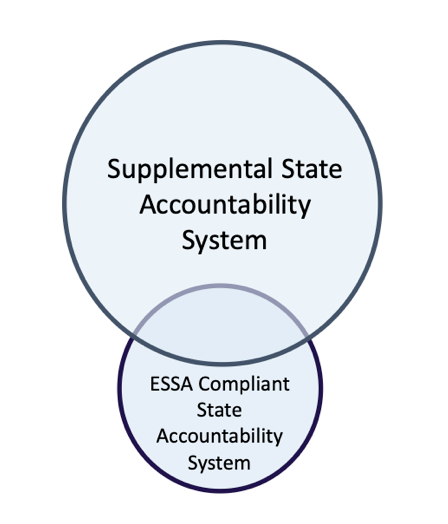
Another point of view is that ESSA requirements are only partially in-line with state priorities. Accordingly, the state may wish to diminish some aspects of federal requirements but more fully incorporate others into a supplemental state system. By doing so, the ESSA requirements become a subset of a broader and potentially more flexible system, since the supplemental system is unconstrained by federal requirements.
There are many ways to design and implement hybrid systems that loosely couple federal and state priorities. One approach is to use ESSA requirements in combination with other elements to designate schools for Comprehensive Support and Improvement (CSI); all other schools are evaluated on a supplemental system.
For example, the supplemental system might include a broader set of indicators (potentially inputs as well as outcomes) or may afford districts some choice among options. The supplemental system could be used to differentiate school performance in ways that are not addressed by ESSA, such as designating schools for commendation.
5. Dual Systems – Decoupled
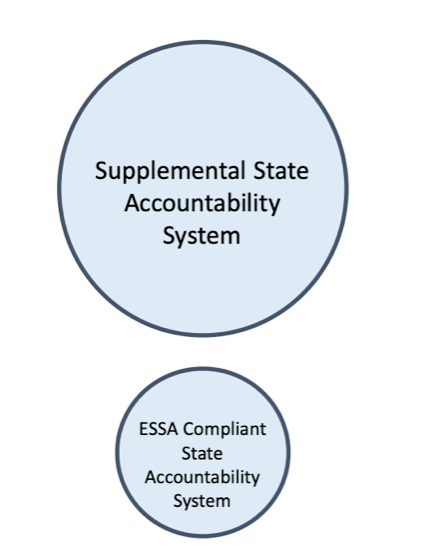
Finally, some states may embrace their role in providing a robust state accountability system but feel their priorities are not congruent with ESSA. These states may wish to build a separate state system that is fully decoupled from federal requirements. Presumably such approaches would seek to minimize the influence of ESSA, shifting the focus to the state system which would be outside of federal requirements.
While this approach would allow the state to maintain its influence with school accountability with maximum flexibility to pursue innovations, a potential downside is that it could send conflicting signals about school performance. This old expression comes to mind: “If you have one watch you always know what time it is; if you have two you’re never sure.”
Summary Table: Five Accountability Models
The table below provides another way to imagine the distinctions among the five models I described above.
| (1) Single Streamlined System | (2) Single Streamlined + Supplemental Reports | (3) Single Broad System | (4) Hybrid System (Loosely Coupled) | (5) Dual Systems (Decoupled) | |
|---|---|---|---|---|---|
| What is the state role? | Implements minimum accountability system required by ESSA. Accountability primarily addressed at the local level. | Implements minimum accountability system required by ESSA. Shift state emphasis to reporting and support. | Develops a single robust accountability system that goes beyond the requirements of ESSA. | Implements accountability system required by ESSA as a subset of broader, more flexible state system. | Develops two systems: one streamlined to meet the requirements of ESSA; another that reflects state priorities. |
| What indicators are included? | Indicators required for ESSA. | ESSA system includes required indicators only. Additional indicators are reported by the state. | Wide range of indicators reflecting state priorities in one system. | ESSA system includes required indicators. Additional indicators to reflect state and local priorities. | ESSA system includes only what is required. Separate state system includes indicators to reflect state and local priorities. No overlap. |
| What outcomes are produced? | Classifications required for ESSA only. | Classifications required by ESSA. Additional information is only reported (e.g., dashboard). | Classifications required by ESSA and additional ratings or other information about school performance. | Classifications required by ESSA and supplemental information about school performance, especially for schools that are not CSI. | Classifications required by ESSA and separate state classifications/ information. |
These five models represent just a small set of the full range of alternatives for blending local, state, and federal accountability requirements. For example, some (but not all) elements of accountability not required by ESSA could be delegated to districts, while the state develops supplemental or hybrid approaches for others. Still another variation is to create different solutions for different circumstances, such as a separate decoupled system only for alternative schools.
In the end, “right-sizing” federal accountability starts with a clear view of the state’s goals and priorities and how the state can best support those goals. Once this vision and an accompanying theory of action are developed, states can select an accountability approach it deems best suited to improve outcomes for students and schools.
